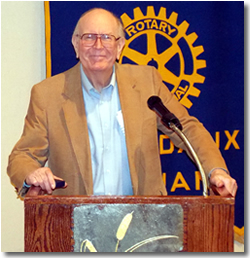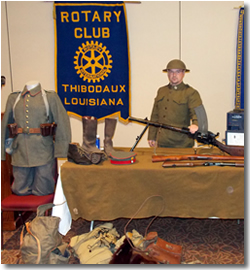Dr. Jim Barnidge – History Of The Catholic Papacy – Thibodaux Rotary Club
March 12, 2013
By: Jamie Gros
 On March 12th, 2013 Dr. Jim Barnidge spoke to Thibodaux’s Rotary Club on the history of the Catholic Papacy.
On March 12th, 2013 Dr. Jim Barnidge spoke to Thibodaux’s Rotary Club on the history of the Catholic Papacy.
Barnidge is a retired history professor from Nicholls State and has spoken to our Rotary club in the past. In fact he was voted speaker of the year for his wealth of knowledge of the crisis in the Middle East. He is also known for attending Europe trips with students and community members for 40 years now.
Given the Catholic Church is going through a change in the Papacy, Barnidge greeted the rotary club with a brief, but entertaining knowledge of the History of the Roman Catholic Church.
Jesus Christ, only taught his teachings, which the Catholic Church is based on for three years. The teachings of Christ were not put onto paper until 3o years after Christ was dead.
It was repeated by word of mouth at first. He set the foundation for his disciples to spread the Word, one of his main disciples Peter is known to have start the church. He actually started churches in several other areas before coming to the main city Rome, where his is ultimately crucified
Peter is not actually crucified in the coliseum, where most events went on in this day and age, he is crucified in what is known as the Circus, which is what Nero the Roman emperor of the time called it. The circuses were literally graveyards, which is what is known today as THE VATICAN, which was the Roman god of the dead.
During this time in the church, before converting to Christianity Peter wanted an individual to become Jewish, it was not until Paul, who was not a Jew, who changed this for the church.
The church slowly developed, its followers waited and waited for the second coming of Christ before they realized the Church needed some organization. There were no real priest at first, but to take care of the needs of their follows they appointed deacons, to take care of the sick and needy.
They also needed someone to take care of correspondence, which was the presbyter, and then someone need to see over them, which were the bishop, above them were the arch bishop and so on and so forth.
The real popularity of Christianity did not start until around the year 300 A.D. Constantine and Maxentius went to war over the Roman Empire. One group of follows was for Maxentius, were sun god worshippers and the other side were followers of Christ; even Constantine was not a Christian himself.
Constantine wins the war and makes December 25th the birth of Christ to deemphasize the sun gods because this was on the winter solstice, the darkest day for these people by also igniting the Birth of the SUN or SON. In many churches today the Saints are depicted with a ray of light behind them or a halo. This was taken from the sun god worshippers.
Constantine saw all the fighting going on and he came up with the Nicene Council to declare the beliefs of Christianity, which is the Nicene Creed, which Catholics still use today in mass. Constantine remained a pagan his whole life until his deathbed, which then he converted to Christianity.
The Catholic Church has been plagued by controversy for years and years. The voting will be done by a group of 115 cardinals, however it can be more but a cardinal cannot vote over the age of 80. There is however, global in balance.
The Latin Church makes up42% of the church population with only 16% of the cardinals; Europe is 24% of the church population and 53% of the population of cardinals, where Africa is 15% of the church population and only 9% of the population of the cardinals.
There is a language barrier located in this it is population. It is very unlikely for a cardinal from the United States become pope. There are many front runners to become the Pope of the Catholic Church; however any adult male who is baptized in the Catholic Church can become pope. But this is very unlikely.
On March 13, 2013 The Roman Catholic Church announced a new pope, First pope from the “New World”, a Jesuit priest, a man of the poor. Cardinal Jorge Mario Bergoglio, Pope Francis I! The new pope will replace Benedict XVI, whose surprise resignation last month prompted the 115 Roman Catholic cardinals to initiate a conclave, a Latin phrase meaning “with a key,” to pick a new leader for the world’s almost 2 billion Catholics.
Thibodaux Rotary Club | Ben Bernard “What They Saw In WW1”
November 13, 2012
By: Ken Gros
 Ben Bernard returned to the luncheon Tuesday with another interesting edition of “What They Saw” – World War I. He gave us a very brief history of the war and once again with the help of uniforms, equipment and weapons painted a portrait of the ordinary American and German soldiers.
Ben Bernard returned to the luncheon Tuesday with another interesting edition of “What They Saw” – World War I. He gave us a very brief history of the war and once again with the help of uniforms, equipment and weapons painted a portrait of the ordinary American and German soldiers.
For those who missed Ben’s previous presentations, “World War II – The German Soldier” and “What they saw – Vietnam”, Ben is a native of Cut Off and now lives in Thibodaux with his wife Lara and son Logan. He is a sales representative from Hyundai of Houma and Living Historian.
Ben is a historian and teaches through living reenactments for the National World War II Museum in New Orleans, Regional Reenactments, and visiting area schools teaching children about the life of the soldier in wars from the American Revolution, the Civil War, Vietnam and everything in between.
Ben has appeared in several History Channel programs based on World War II and the Vietnam War and assisted with the development of World War II Video games such as the popular “Call of Duty”. Ben’s grandfather was a Major in the Korean War and he became interested in war history at an early age. Ben has spent many hours with our fighting soldiers gaining an understanding of how war feels, and what is life really like for the men on the front lines.
Previously, Ben stressed the importance of detail, no matter how small, for reenactments to be successful. Participants “become” the soldier they are portraying and the more realistic the presentation the more informative it is.
Ben gave us a brief history of World War I. It was the first “Global War” and was different than any other conflict ever seen. It was a complicated war. Multiple nations were involved and were assembled in two opposing alliances, the Allies (France, Britain and Russia) and the Central Powers (Germany, Austria-Hungary and Italy).
America entered the war with the Allies in 1917 and fought until it’s conclusion in 1918. New technologies including aircraft, tanks, machine guns and chemical weapons were used. Because of these advancements in technology – and lethality of the new weapons, World War I was one of the deadliest conflicts in history.
Although both sides had plenty of new, impressive weapons, the soldiers in the field looked pretty ordinary. Ben was outfitted as an American GI or “Doughboy” including his brown wool uniform, low booties and a soft hat. He also donned a typical knapsack with usual implements including blankets, shovels and mess kits.
He explained how surprisingly, countries were just beginning to realize it was important for their fighting men to be comfortable in battle. GI’s standard rifle was the Springfield 1903 bolt-action 30-06. Select GI’s were issued the Winchester 1897 12-gauge shotgun which was very effective for trench warfare, however those who wielded it were shown no mercy if they were captured. Ben also showed us a standard issue “turtle shell” steel helmet with a crude camouflage pattern.
Next up was the German soldier. As usual the Germans appear to have one the fashion war. They donned a field grey wool uniform, leather boots with hobnails and a steel stahlhelm helmet – affectionately dubbed the frankenstien helmet by the allies because of two studs on its sides for attachment of a steel shield.
The helmets continued to be used throughout World War II. Soldiers used the Gewehr G-98 bolt-action mauser – the predecessor to the famous K-98, 8mm. Similar to other wars, the quality of uniforms and equipment was diminished by the end of the war as resources became scarce. Ben tried on a crude German gas mask; a grim reminder of the brutality of war.
When asked which soldier he prefers to reenact, Ben said the German soldier and went on a long explanation of why. I think it’s because the Germans seemed to have cooler toys than the Americans. Thank you Ben!
